Mismatched numbers
Kyle Perkins asks:
Here’s pics of my recent S-6. It sounds incredible. The label reads 1658 but the penciled in # below the label reads 1686. Can you explain the different serial numbers?
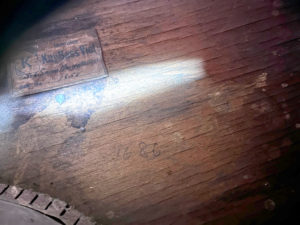
Here’s my supposition, not based on any documentation, but it makes the most sense to me and I expect it’s pretty close to reality.
When a build order came down, the shop personnel would pull parts for the instrument from stock and mark the back with what I call the build number, referencing that order. After assembly and major finishing the inspector would apply the ID label with the serial number. These numbers are usually the same, but for various reasons a given instrument might move through the process more quickly or slowly than expected, and the numbers may not match in the end. This doesn’t show up often, but it happens, more often in the early days, when shop procedures were still developing. As an example, in the span of #s 1459-1659 we currently have 17 basses with enough documentation to show that four have mismatched numbers, a relatively high ratio.
The build numbers disappear at about #46800, in mid-1963, coinciding with a switch from handwriting to a rubber stamp for serial numbers.
Registry update, November 1 2022
Registry Update
New registrations in October: 30
Registration updates: 21
Total registrations: 8316
Average prices in October:
C-1 $2306
M-1 2725
M-1B 2916
S-9 3350
H-10/M-3 910
Bass of the Month
My friend Bernd Eltze in Essen, Germany, an early rock’n’roll player, aficionado and collector, picked up this S-8 Swing Master from the son of Russ Smith, bassist with Ron and His Rattletones out of western Connecticut in the late ’50s and early ’60s.

Available 1938-’54, the Supreme-series S-8 is the non-blonde sibling of the S-9, and together they represented the top of the Kay bass line for the postwar period, inheriting the Swing Master nickname from the S-5/S-6. This one comes with a great story.
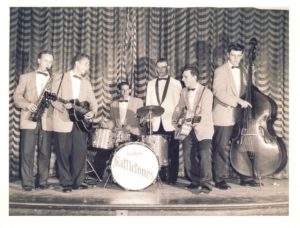
Ron and His Rattletones onstage
Based at the famed Crystal Lake Ballroom in Ellington CT, The Rattletones was the first band Gene Pitney appeared onstage with, and was Chuck Berry’s first choice for backup on New England dates during his peak years. The band recorded two singles on the Glo label and backed up many touring performers, including Don Gibson, Bobby Darin, Dion and the Belmonts, Bo Diddley, Neil Sedaka and Frankie Avalon.
Smith held the chair in this band throughout, and the bass still carries fingerboard decals spelling out RUSS. Built in 1953, it remains in exceptional condition. To me it speaks eloquently of the thousands of hard-working musicians few remember who built American popular music.
Cello of the Month
New Registry member Dylan Sapp in Georgia received this cello from his aunt, who’d found it set out on the street with trash, and he’s interested in restoring it. At first glance it doesn’t look like much, but it’s a score for the research, a 140. I’ve classed in the Supreme series, but that’s tentative for now, and I’ll explain why.
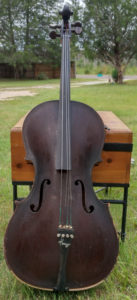
Kay’s 1947 model-line revamp updated the cello lines and brought in a new designation system, holding over only the trusty 55 group (Student series) and adding the 110 (Orchestra), 120 (Concert) and 130 (Maestro) groups. In 2017 we found the first 140 survivor, with high-end details. As far as I know this model was never catalogued, and I speculate that it was meant to replace the prewar 165, which is similarly rare. Five years on, the second one has appeared, confirming its production-model status and features, including ebony appointments and edge purfling, as well as extending its production span from 1948 into ’49. The finish here is quite dark, possibly from exposure, but the ’48 survivor carries the same lacquer contrast pattern as the 165.
What’s difficult about this model is that excepting its contrast pattern it seems to be the same as the 130 in its details. Why make two different models the same way at the same time?
I have this question about the earlier 75 group, too, which differs from the 60 only in its price. The early cellos got their model designations from their target retail prices, so the 75 was priced 25% higher than the 60, and it’s difficult to imagine how a salesperson could justify this degree of price differential — close to $500 in today’s money — for what was essentially the same instrument. The 75 group was discontinued by 1941 while the 60 went on for another seven years. Why would Kay choose to repeat that mistake amid what was clearly a reform initiative? Was it just cockeyed optimism about the postwar return to the kind of economic prosperity not seen since the ’20s? I’ll have to put a pin in that pending more data. Let’s hope I’ll see another one before 2027.
140: ’48-’49 (so far), 4/4 only, likely fewer than 50 built
Registry update, October 1, 2022
September marked six months of steady growth in Registry traffic, more or less doubling since the lull in April. About half the September registrations and updates are sale-related. Prices seem to be ticking slowly upward, though still well behind average inflation.
New registrations in September: 29
Registration updates: 24
Total registrations: 8287
Average prices in August:
C-1 $2536
M-1 2440
M-1B 3282
S-9 4733
H-10/M-3 844
Bass of the Month
Our friend Kyle Perkins in Kentucky found this rare bird for sale in Maryland. This otherwise standard-spec M-1 from 1950, from the family of the original owner, carries the distinctive difference of its Silvertone tailpiece badge, the first I’ve seen.
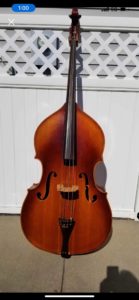
Kay started supplying instruments to Sears before it was called Kay, and by 1940 its basses were appearing in America’s biggest catalog too, remaining on offer till Sears abandoned the strings market in ’59.
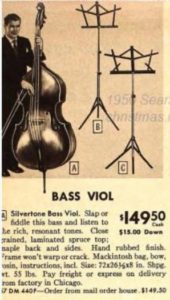
Kay’s OEM business volume varied somewhat through the years, but it was a major component till the distributor and consumer catalogs began to ebb in the late ’50s. Those OEM customers with their own brands typically preferred that the instruments come with no Kay badging or identifying labels, and we see that with this example as well. If you’ve heard the rumor that Kay inspectors simply neglected to put ID labels into a lot of basses, I can say conclusively that it’s just not true.
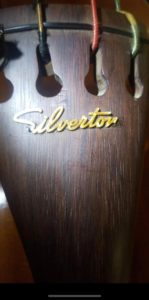
The badge itself is plastic and glued to the tailpiece, unlike the metal Kay badges that are pinned into the wood. We can see in the photos why so few of these have survived.
Thanks Kyle for the tip!
Cello of the Month
An unusually large group of cellos and 1/4 basses joined the Registry in August, among them this relatively rare 100, marketed as the Artist.

Offered only in 1938 and ’39, the 100 and 100B were the only Maestro-series cellos for the prewar period, pitched below the Supreme-series 201 and 165, with some appointments from the Supreme series (ebony fingerboard, edge purfling) and one detail from the O-100, the rear center stripe. 4/4 only, about 325 made, including about 50 blondes.
The model designations of prewar cellos were set by their introduced retail prices in ’37 or ’38, a practice that extended to the bass side only with the 89.
Registry update for Sept. 2, 2022
New registrations in August: 24
Registration updates: 24
Total registrations: 8260
Average prices in August:
C-1 $2340
M-1 2673
M-1B 2694
S-9 4048
H-10/M-3 1087
This month it appears that demand is picking up, with several instruments sold after sitting for up to a couple of years, and newly selling lower-priced instruments going quickly. It’s not yet 2019 again, but we’re getting there steadily.
Kay and Volkswagen: Products for the People
I’m an old-car guy and have kept and worked on various Volkswagen products over the years. Something occurred to me one day that I think could be illuminating in looking at these instruments. In terms of their customer targets and approach to serving them, Kay was a lot like Volkswagen in its air-cooled days.
(more…)
Kay Serial-Number Reference
Serial numbers for all Kay basses and cellos, built between 1937 and October ’69.